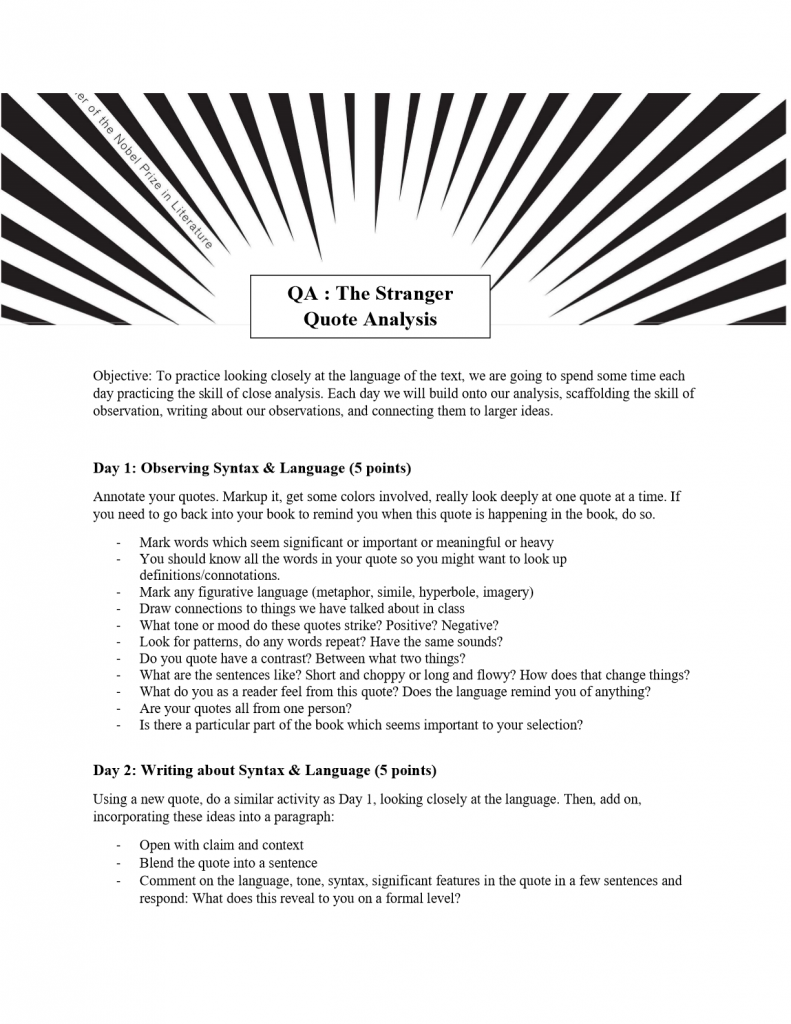Classroom Culture
I hope that when students come into my classroom they feel like they can be themselves, take risks, and have fun. My classroom culture gives students space to express themselves – the environment encourages imaginative thinking and critical inquiry, and is a place they can have fun. I do this daily, welcoming the students into the classroom, and asking them questions about their lives outside of school. “What’s new? “You got your driver’s licenses? Awesome, let’s see the photo!” “What trail did you hike and how hard was it?” “Who can fill us in on last night’s volleyball and ultimate game?”
I work to balance this openness and playfulness with consistent and clear boundaries and expectations. Being warm and lighthearted but also maintaining structure and control of the class. I think this balance and spectrum of interactions can be challenging for some students, but ultimately I’ve found it a successful way to both engage with the students and set clear expectations. Whether in person or remote, developing a thoughtful classroom culture is one of the most important things I do as a teacher.
Selected Student Feedback on Classroom Culture
[RESIZE IMAGE BELOW]
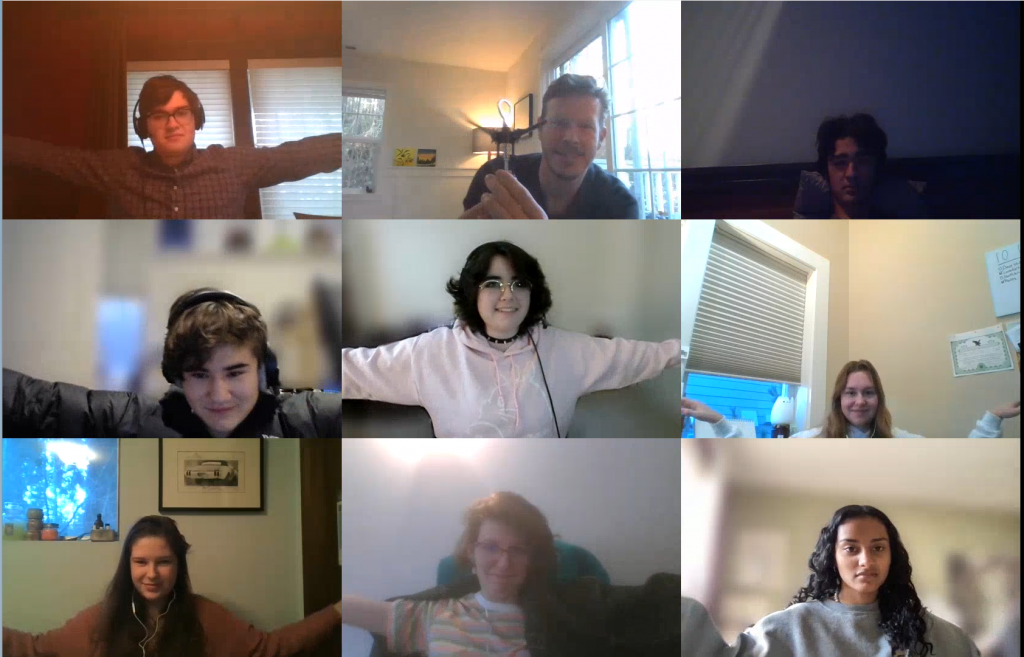
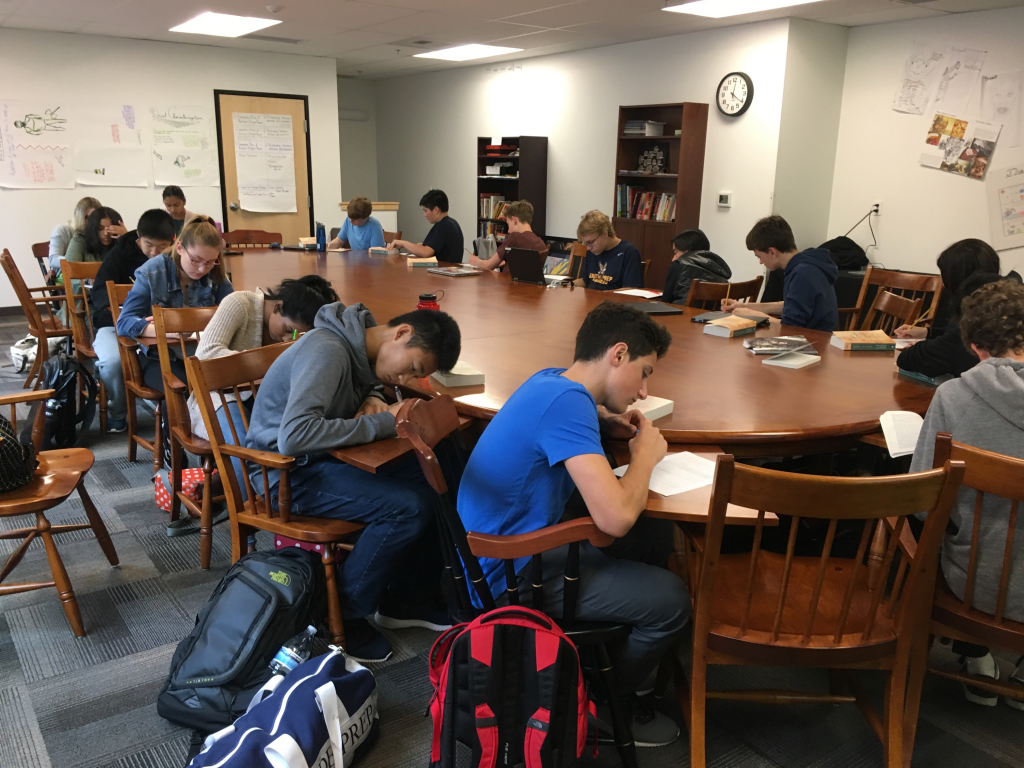
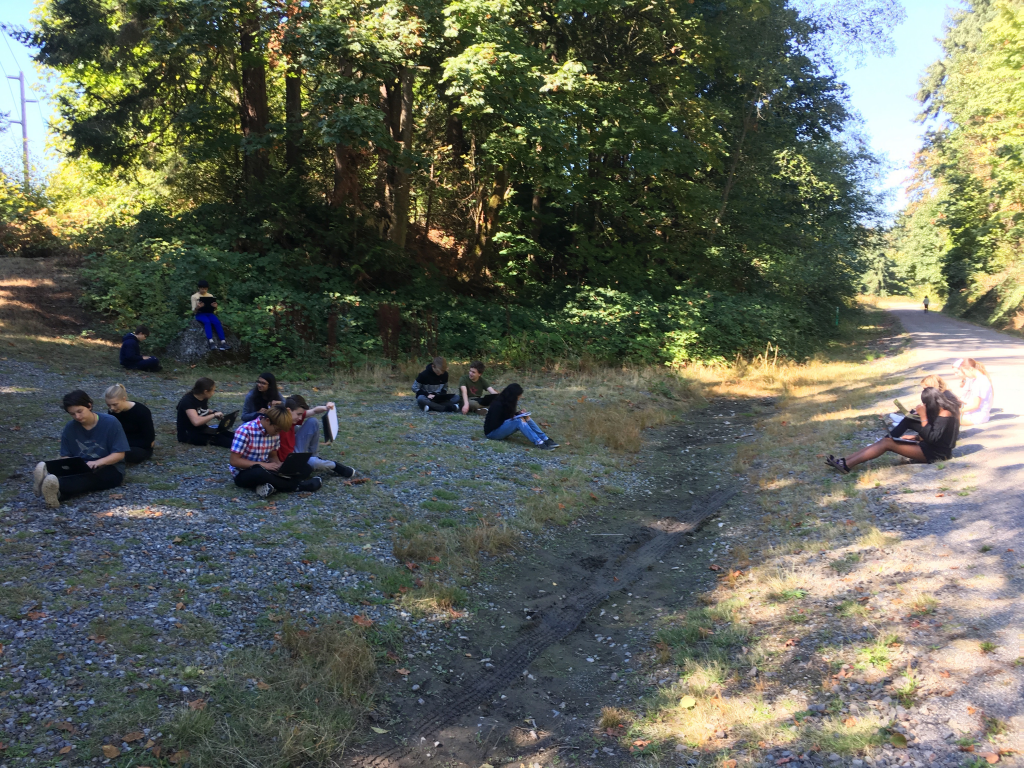
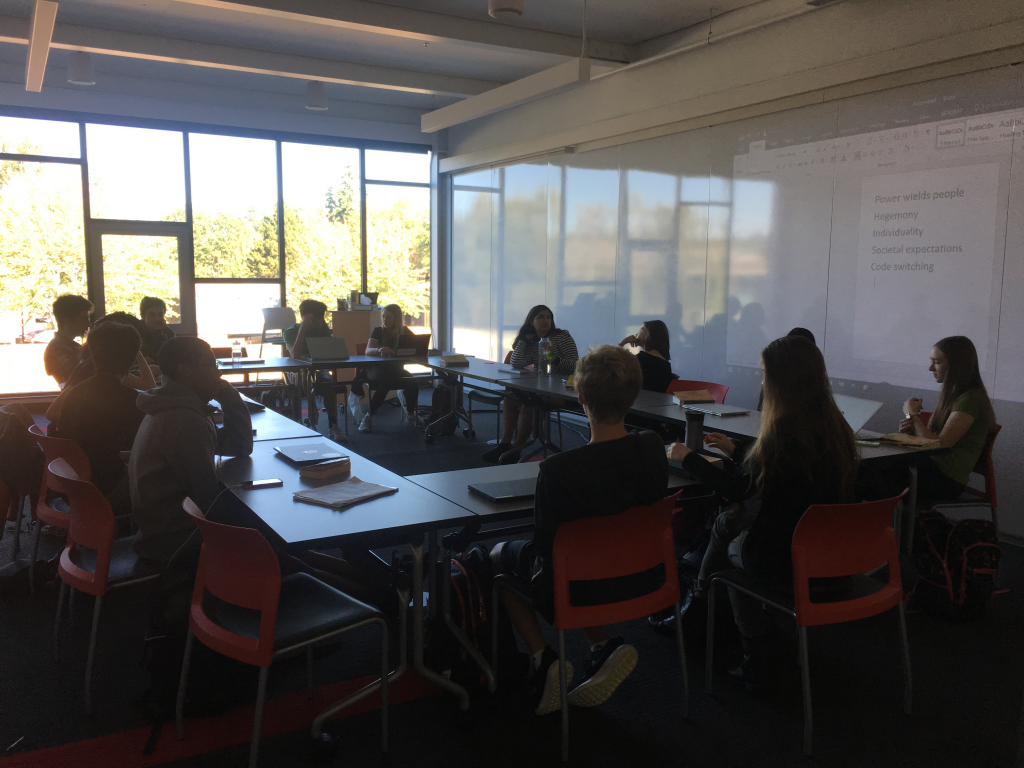
(1) coaches and reinforces peer-to-peer dynamics that are appropriate and constructive
Creating and fostering a community in which students engage with one another in both small groups and as a class, while listening to and supporting one another is central to my teaching. Yes, I want students to walk out of the class inspired by a text they read, continue to ruminate on a character they’ve grown to love, and make connections between the class and their lives, but there’s more too it than that. I feel one of the most important things we can teach our students is how to collaborate, listen to and learn from each other, and engage in dialogue that encourages respectful debate. This often starts by creating assignments in which students engage with each other.
Central to creating an environment that encourages positive peer-to-peer dynamics is considering the student’s level of confidence. I develop homework assignments that are designed so that students come to class with the confidence they need to interact with each other as well as myself. This is seen in my Harkness Discussion Preparation and Reading Guide. This assignments provides students the opportunity to prepare more formally before the discussion begins. When students feel confident in their understanding of the material they are better able to engage with others in small groups.
Another way I coach peer to peer dynamics is by assigning roles during our class discussions. This provides students with a clear assignment for the discussion. It helps to avoid students dominating the conversation as I can call on specific roles to respond to various topics.


Another way I support peer-to-peer dynamics in the classroom is to scaffold assignments that ask students to think critically about complex topics. Cross the Line is a great warm-up activity that encourages students to first talk to each other about simple topics, how is your day, what are you excited about this weekend, before engaging in more complex and challenging topics. Starting the discussion by having students move around in the classroom talking about themselves provides them with the confidence they need to jump into the harder stuff with each other. [PICTURE OF CROSS THE LINE]
Lastly, I’ve tried to further scaffold my Harkness discussions so that students feel less on the spot and can engage in a small group discussion before jumping into the larger conversation.
Finally, I’ve started using a triad model when approaching a Harkness discussion. Students will sit in groups of three, a question is presented on the board, and the group of three will discuss. They will then select one of the group members to participate in a six person discussion. A student reflected on this process saying they appreciated the fact that they did not have to be ‘on’ and trying to think on the spot about something to say the entire time. They also mentioned that they were able to hear much more of the conversation.
This often leads to increased engagement and participation in the larger class discussions.
(2) communicates behavioral expectations that are appropriate to class activities
One year EPS experimented with desks that had attached chairs and could roll around the classroom. I thought it was a great idea as students could reconfigure themselves quickly from individual, small group, and class discussions. I remember teaching the 10th graders on the final period of a sunny day in the spring. I was working with a small group of students on one side of the classroom when the sixth-sense teachers often have began to perk up. I looked at the other side of the class and saw a group of students lined up on opposite sides of the room. I had no idea what was going on until they began to joust. As fast as their legs could scoot them across the room they were on a collision course. “Hey, what are you doing?!” I headed over to the room to tell them their behavior was clearly inappropriate. Meanwhile, on the other side of the room students, inspired by the jousting tournament, began spinning their desk/chair combos in circles as quick as they could. I had lost control. It’s difficult to say whether my lack of communicating behavioral expectations appropriate to the day’s class activities or the spinning desks play a greater role in the chaos but I will say that the desks only lasted a year…
Students need structure, clear expectations about what to do when they come into the classroom, how to move about the classroom, and what to expect in a given period. In the case in my classroom, I try to balance reinforcing appropriate behavior without the need for Draconian punishments if something does not go as planned. My goal is to communicate the overall behavioral expectation for them to listen to each other and participate respectfully in class. Expectations are appropriate to class activities and align with creating an environment that is playful and fun but one that students understand what is appropriate. There’s a few ways that I communicate these expectations, for example, sometimes I will share a list of rules and consequences
[Include Harkness Norms and syllabus that establish behavioral expectations.]
These observations from my PDP team highlight the way I balance a sense of play with high expectations in the classroom.
(3) develops a mutually respectful relationship with each student, instilling confidence that the teacher is invested in their success
Working with students is fun. Their energy, interest in so many different topics, humor, and thoughtful commentary in class keeps me coming back year after year. It’s impossible to develop a relationship with students as the ‘sage on the stage’, rather by getting to know them individually, and people outside of the classroom, I’m able to connect with them in a meaningful way.
This begins by treating students respectfully, as equals in the classroom. I often ask students questions as they come in the classroom, inquiring about their weekend, their extracurricular activities, what they are excited about or working on, etc… This creates an environment that is more than simply a teacher delivering content to students. And in the end when I continue to find myself in situations such as a jousting tournament breaking out what else can you do but smile and laugh. It’s high school after all!
EPS is also a place of humor. It’s possible that sarcastic humor is the love language of our school. I’m reminded of a time joking with a 12th grader about banging his head on the wall of the classroom to persevere through challenging material. Sometimes it hurts! Later in the year the student, along with Eric Claesson and Karen Mills created a podcast of this conversation. While much of the story was hyperbolic, and funny. It reflects the respectful and fun relationship we had. He knew that while I was setting a high standard for him I was not going to let him fail. I like to think of this brief podcast as his way of saying thank you.
Mr. Keedy Podcast
(4) demonstrates cultural competence by promoting inclusivity
As an educator I try to be as inclusive as possible by being aware of the various cultures represented in my classroom. Additionally, as a while male who grew up in the United States, I second guess myself at times on whether or not I’m actually promoting inclusivity or simply paying it lip service, which is not an easy thing to sort through. This indicator continues to be an area I’d like to continue learning more about so as to make the classroom an even more inclusive environment.
The experiences I’ve had as part of the EICL program have helped me to focus on many things that promote inclusivity, including the texts we select for the students, the projects and assessments the students undertake, and how we encourage students to engage in small group and class discussions. The process of selecting texts has been at the center of our discipline design discussions recently. Below we surveyed many of the texts we read in the upper school to see the diversity of authors and note any areas we feel should be addressed.
| Male | Female | Nonbinary | LGBTQ+ | BIPOC | White |
| 27 | 23 | 1 | 2 | 17 | 32 |
I also demonstrate cultural competence by encouraging students to explore and share topics of interest to them with the class. For example, during the winter trimester seniors select a topics to explore inspired by the content we have worked on in class. I’m continually amazed by the scope of the topics they explore in their Senior Research Papers Their essay topics often reflect a wide array of diverse cultures and interests and their presentations to the class encourage others to learn more about the world around them.
Finally, I try to promote inclusivity in the classroom by providing students time to get to know one another at the start of the trimester. While icebreaker and get-to-know you games can help get this process started in order to dig deeper I try to make connections between the course content and the student’s lives. In doing this students are encouraged to share something more personal about themselves, their culture and family as well as what they value most. This not only provides space for students to talk about themselves but helps build class community early in the trimester. The Medieval Shield project and accompanying personal narrative essay is a wonderful way to establish a classroom culture that embraces inclusivity by encouraging students to share personal stories about themselves and their families.
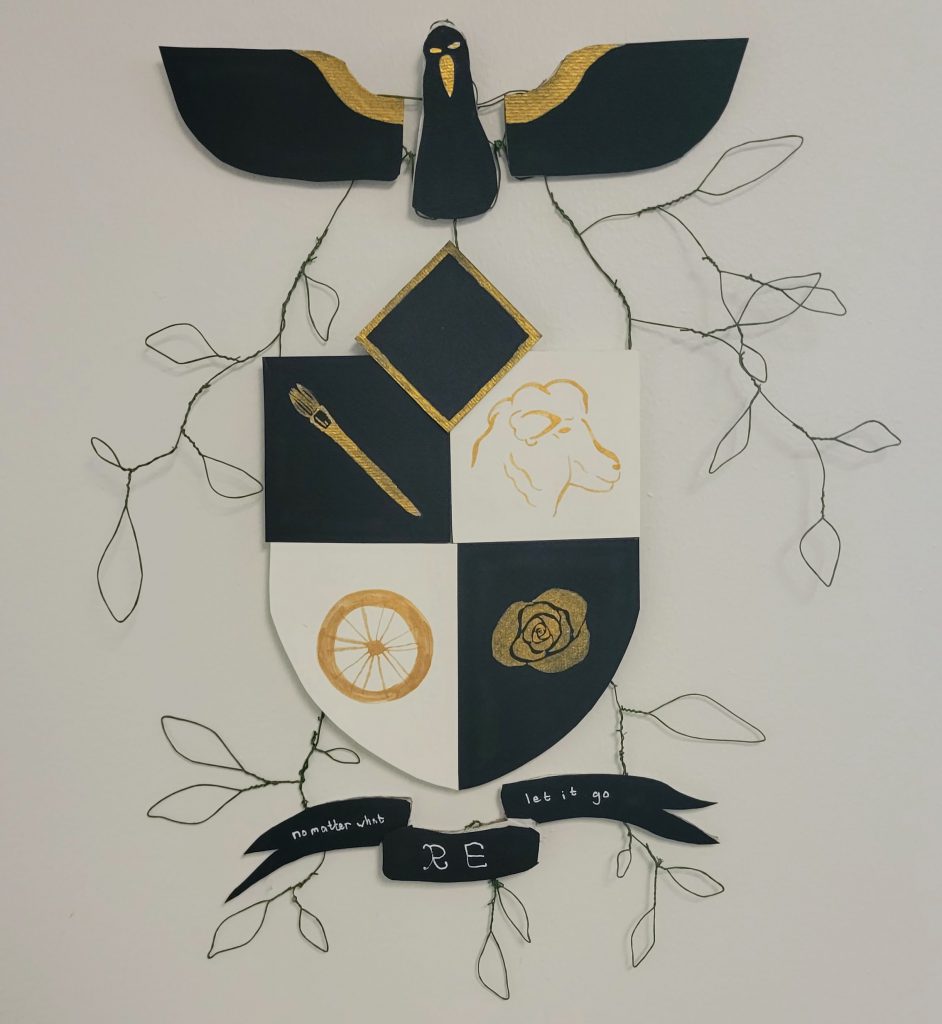
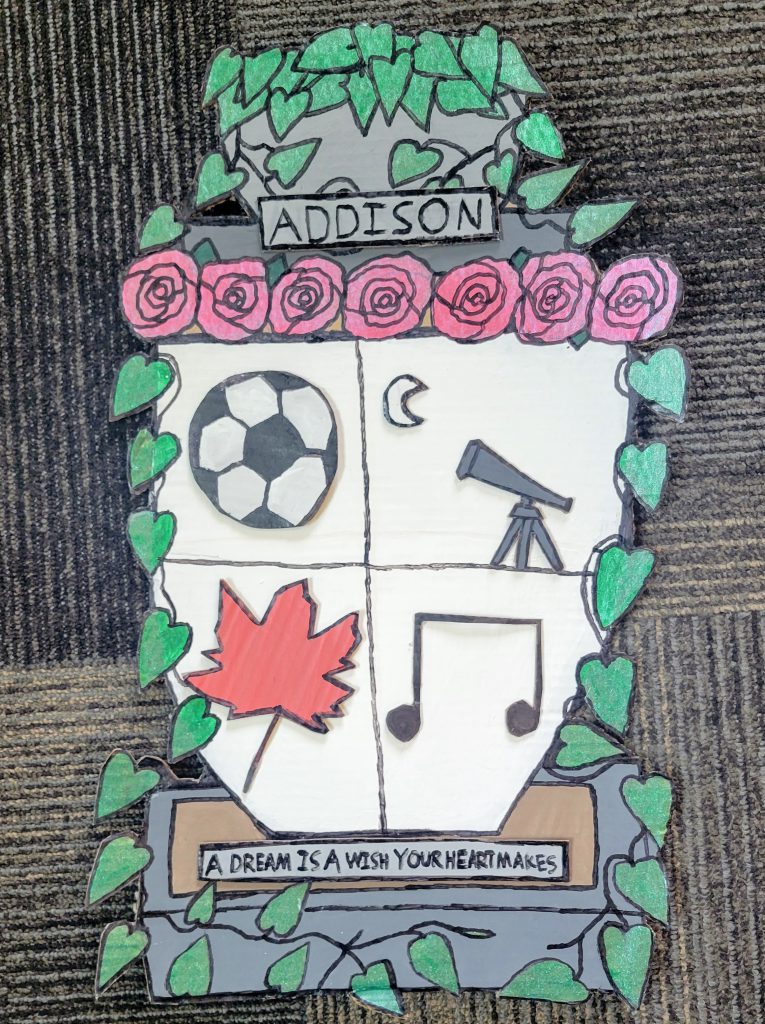
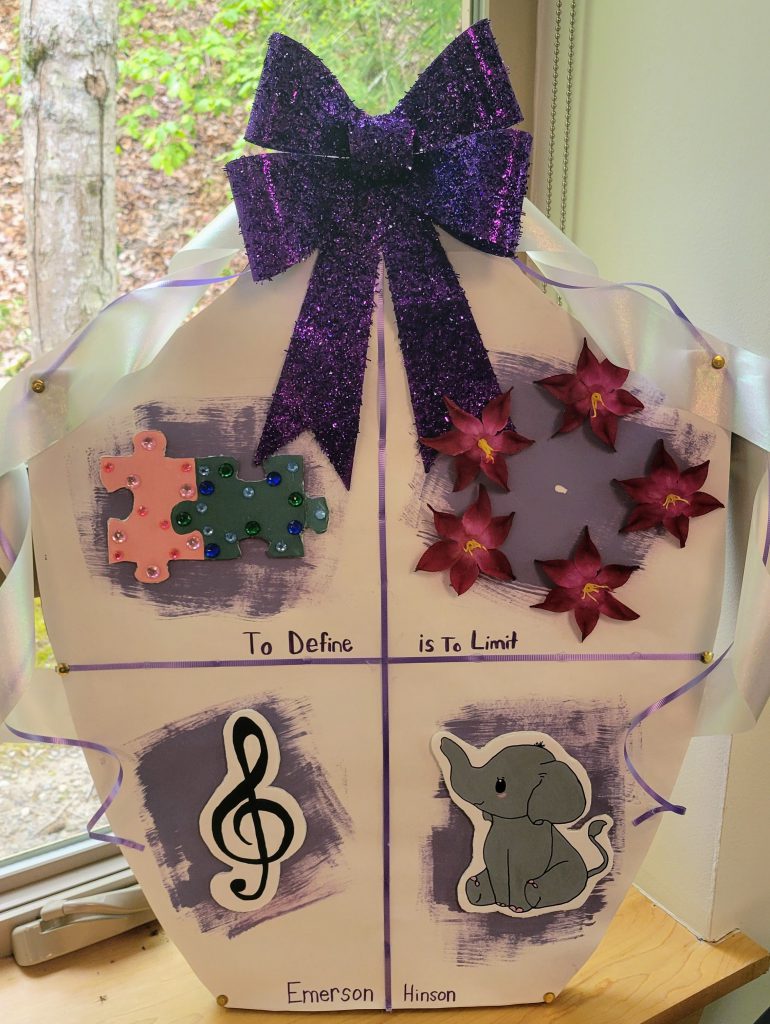
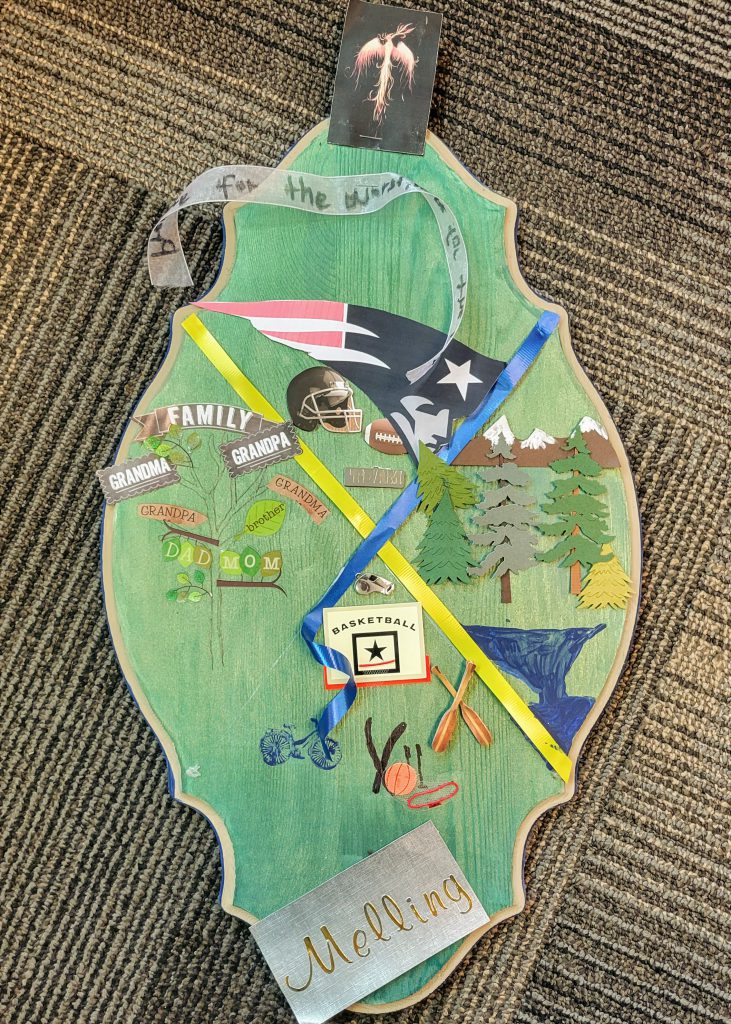
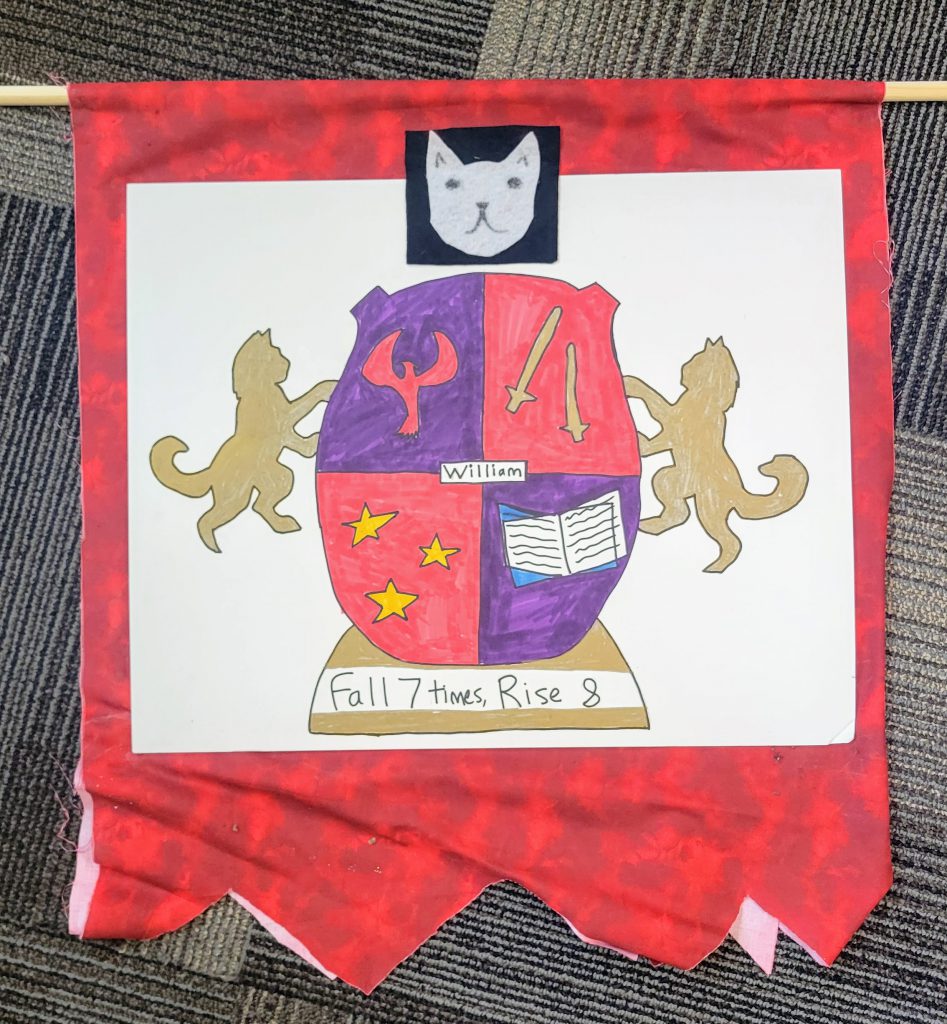
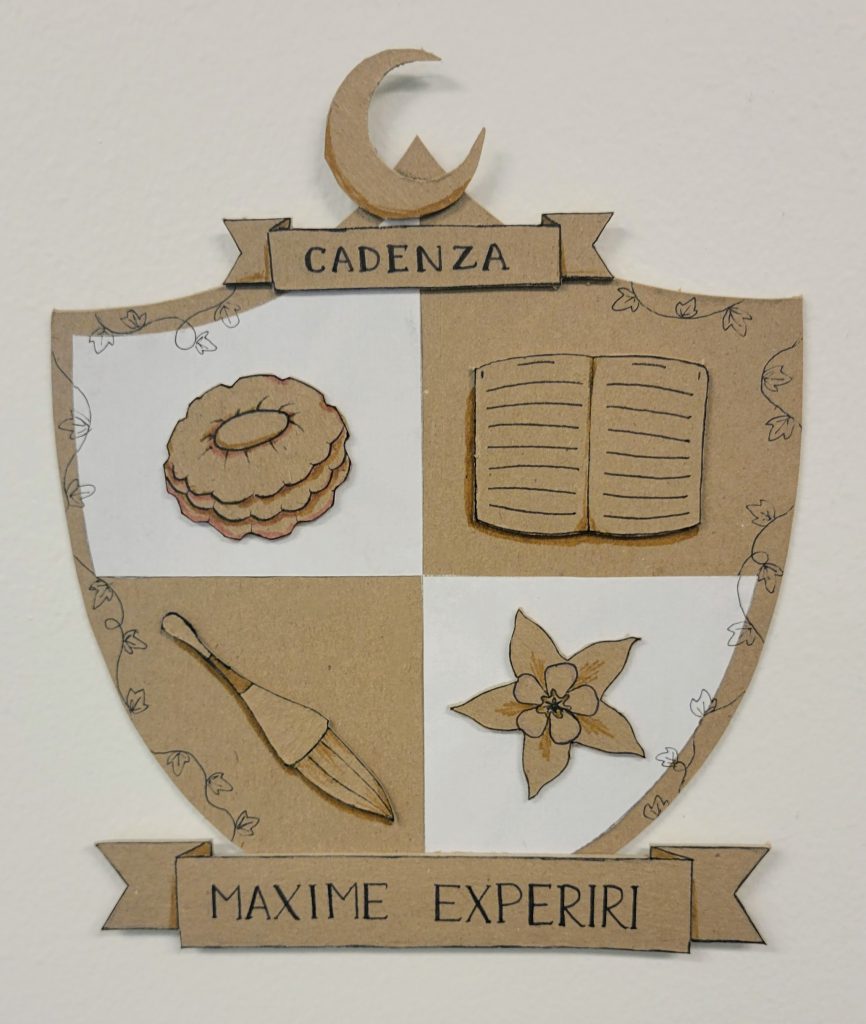
(5) designs and facilitates a classroom culture that promotes student preparedness, engagement, self-advocacy, perseverance, and collaboration
There are countless ways I work to establish a classroom culture that allows students to engage with the content in a way in which they feel challenged and also successful. As I’ve mentioned in other indicators, establishing a classroom culture in which students know they have a voice, listen to and respectfully debate the opinions of others, and feel safe are necessary for them engage, self-advocate, persevere and collaborate.
One way I develop this type of classroom culture is by highlighting the importance of learning for the sake of learning. By offering assignments to students in which no grade is attached they can forget about being right or wrong and simply explore the topics. One student wrote in their student experience survey that their favorite project of the trimester was the poetry unit ‘because there were no grades. I liked that everyone sits together in a circle and reads their poem aloud to the class there’s no right or wrong way to analyze it.’ Having students engage with the material without worrying about a grade often produces some very candid and heartfelt results.
Another way I encourage self-advocacy and perseverance is by offering oppertunities to revies, edit, and peer review their writing. Below are two assignments that are designed to facilitate a class culture that encourages learning for the sake of learning. By doing these activities before grading the final submissions students are able to see that the essay writing process is process that takes time.
Face to Face Grading
Paper revisions protocol fosters self-advocacy
In the classroom, I love to make the kids move the desks and chairs even though I hear their groans every time I ask them to do so. Sometimes we move them into groups of four, then into a ‘mega-desk’ for a large class discussion. These physical transformations of the room support student collaboration and engagement with their peers. John noticed this practice while observing the Western Fiction and Drama class:
“I love that you set the groups up ahead of time, and I love that a few students groaned when you made them move. 😊 This suggests to me that you designed the exercise purposefully to maximize engagement and collaboration, in particular.”
In order for students to engage in the content they need to feel like the classroom, in person or remote, is a safe and fun place. Starting off with some fun icebreakers activities helps students to see that creating a positive classroom culture is essential for their well-being and learning.
Remote Teaching Icebreakers
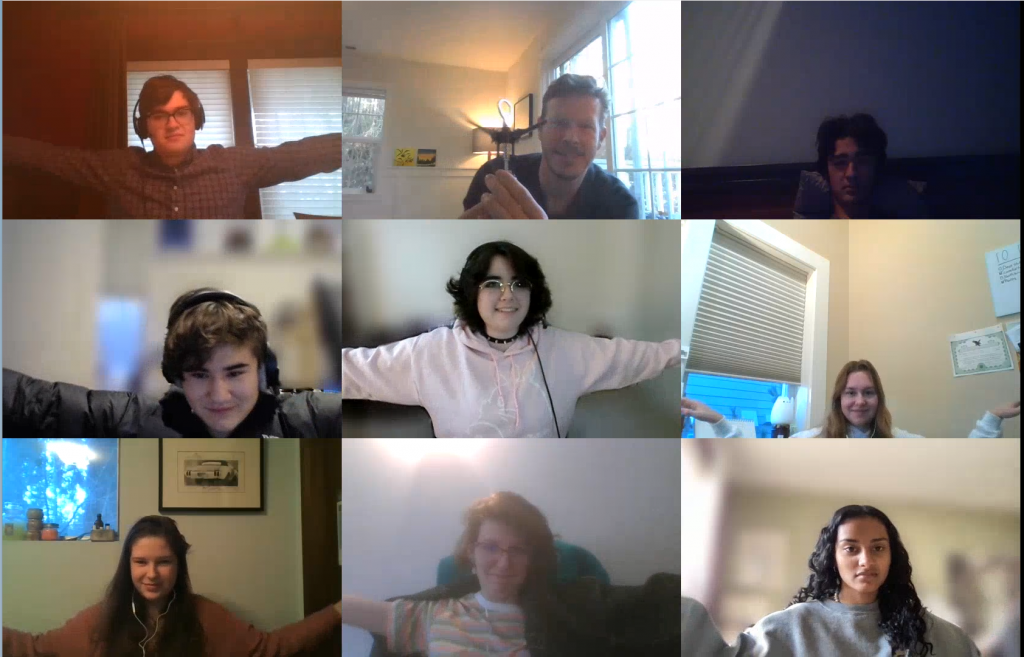
Pedagogical Effectiveness
(1) begins class sessions with a clear statement about the lesson’s objectives and place in the progression of course
In the classroom, I try to find a balance between structure and spontaneity. This begins with a clear and thoughtful agenda with goals for the day that are connected to long term assignments. For many students, structure and routine in the classroom is very important. Knowing what to expect before walking into the room gives students confidence. At the same time, it’s important to know that not every lesson will go as planned and that adjustments will need to be made, often on the fly, with respect to timing and activities.
I provide a detailed agenda for the students in OneNote, outlining the plans for the day as well as any homework assignments they are expected to complete. I often begin class with an activity that encourages some reflection and discussion. Sometimes this is an attendance question asking about highlights from the weekend, or a writing prompt and then sharing a journal response.
Activities at the start of the class often ask students to recall information from previous classes or homework and provides time to prepare for upcoming conversations.
Sample Agendas and OneNote Calendar
[Include PPT slides with reading/discussion questions]
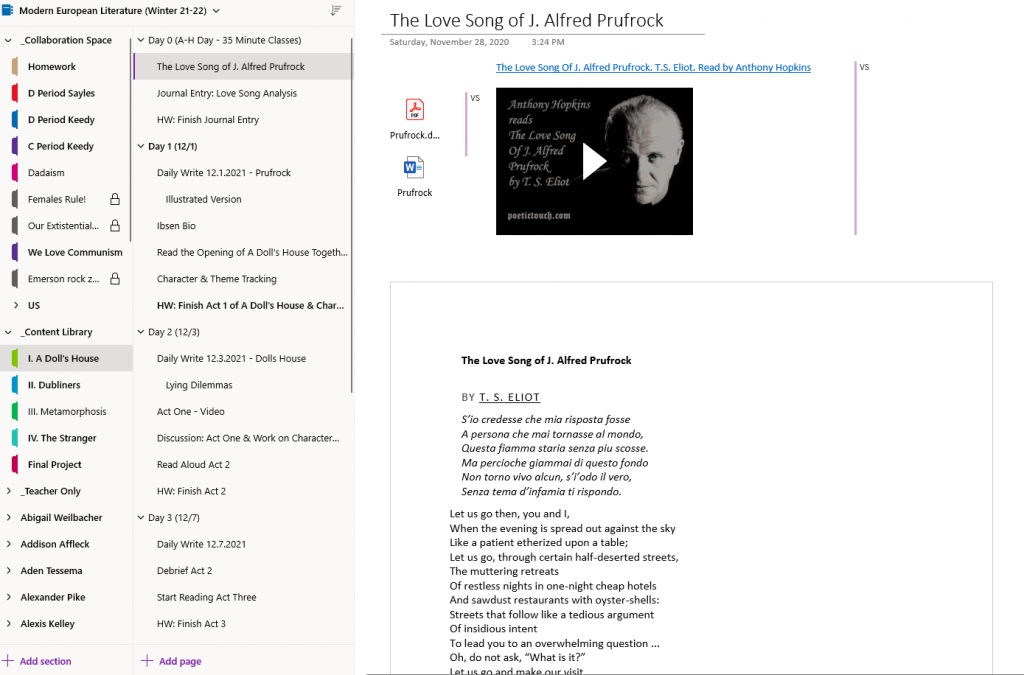
(2) designs and implements varied activities in each class period
It’s important, especially for adolescents, to implement a variety of activities in the class each day. Before building up to a larger assignment such as a paper or Harkness discussion I have students participate in activities, beginning with lower-stakes objectives and building up to more challenging activities. I also try to get the students moving at least once or twice in the classroom, which may involve moving desks or moving locations in response to questions.
[Include the progression of a couple different classes]
-Attendance question, partner share, individual quote analysis, Harkness, quite reading time
Class Observation Comment: This was definitely present today. Not only were the activities varied, they naturally differentiated the student experience. Began by building buy-in with a very accessible affinity exercise, then pushing students to justify their feeling with their reason. Nice progression!
(3) brings each activity to closure effectively and transitions intentionally to subsequent activities
Including a variety of activities in a class period is something I do daily but this necessitates bringing each activity to an effective close to transition to the next. Throughout a single class students might research a concept on their computer, mingle in small groups discussing an engaging question, read from a play aloud, and engage in both formal and informal discussions. Transitioning between these activities in a thoughtful and timely manner is essential. [WHY IS IT ESSENTIAL? TO GET THROUGH EVERYTHING? SO STUDENTS CAN BE MENTALLY READY FOR THE NEXT THING?]
To support this, I try to be very intentional about my expectations, telling students they have five minutes to complete something or letting them know when to expect the next activity to start. I also work to make the flow from one activity to the next seamless, by using short wrap-ups after an activity and introducing what to expect next.
Comments from class observations. [INTRO STATEMENT]
(4) ensures that students are using technological tools effectively
[INTRO JUXTAPOSING HANDS-ON PHYSICAL PROJECTS VERSUS COMPUTERS]
A challenge I often face in classes is balancing getting kids to close their laptop to engage with each other and the reality that much of what we do at EPS is done on the computer. I work with the students daily to help them understand when it is most appropriate to use computers and when to use pen/paper, for example, when making annotations.
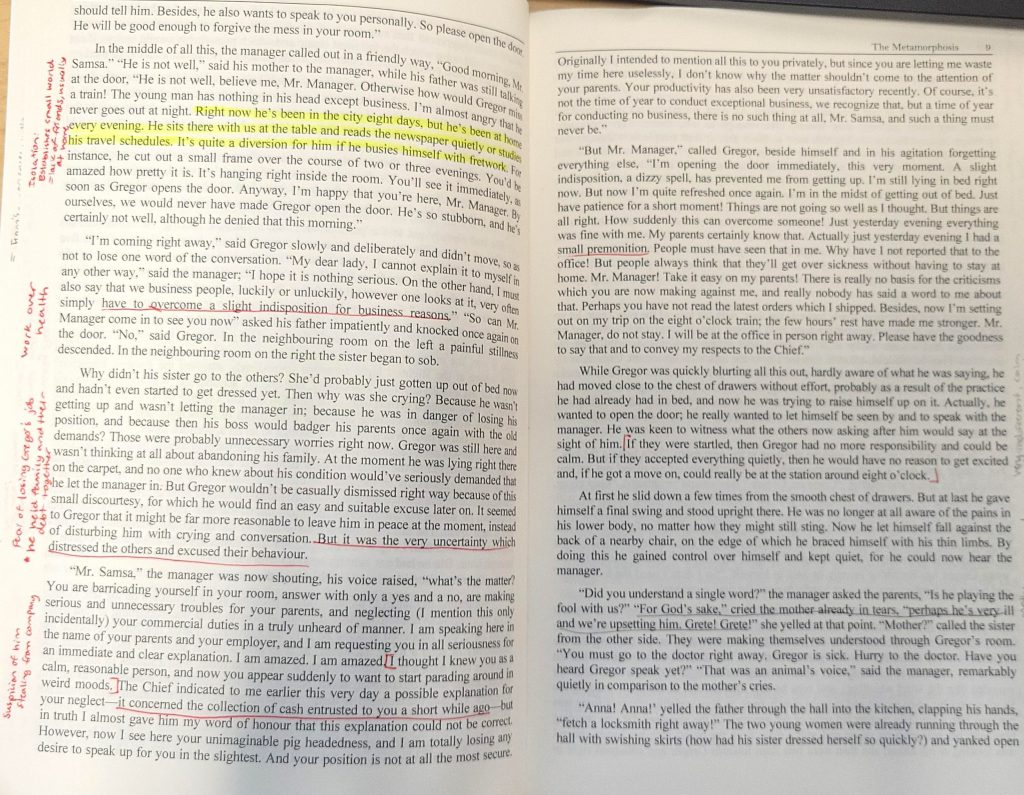
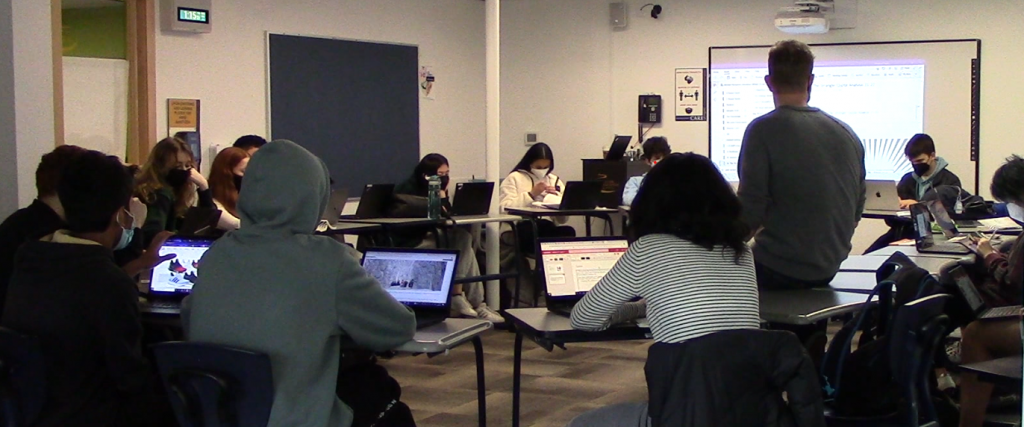
Comments from class observations regarding the use of technology:
“You circulate well. The room is set up in a way that makes it hard for you to get behind kids to see their screens, but they are on task and you can mostly tell this from in front of them. This indicator is basically a non-issue in this session, as it should be. I think more than an enforcement framework, you have headed off any potential problems with expectation and class culture, as well as good instructional design.”
“Fantastic example here in terms of expecting students to edit a physical, printed copy of their drafts. Several students tried to worm out of this expectation. SK was friendly but firm in insisting they print–specifically indicated which TALI printer they could use and encouraging them to do so immediately. SK also explained what advantages editing a physical copy might have–made it clear that this expectation wasn’t arbitrary or meaningless“
(5) concludes class with a summary and clear tie-in to the next class
Timing is essential when bringing the class to a close. End too early and students are standing at the door with their backpacks on, end too late and you’re shouting at them about their homework as they leave the class. Depending on the work we are doing a more direct or indirect approach to concluding a class is taken. Sometimes I simply thank students for their time and engagement and wish them a great day, other times I ask for a quick written response to be submitted to Canvas before they go. [WHY AND WHEN DO I DO THIS]
Comments from class observations:
“Quiet work time until the end of the period; with one minute left: “Upload your text into the Canvas text box”
“When we come back from break, be ready for a fun final!”
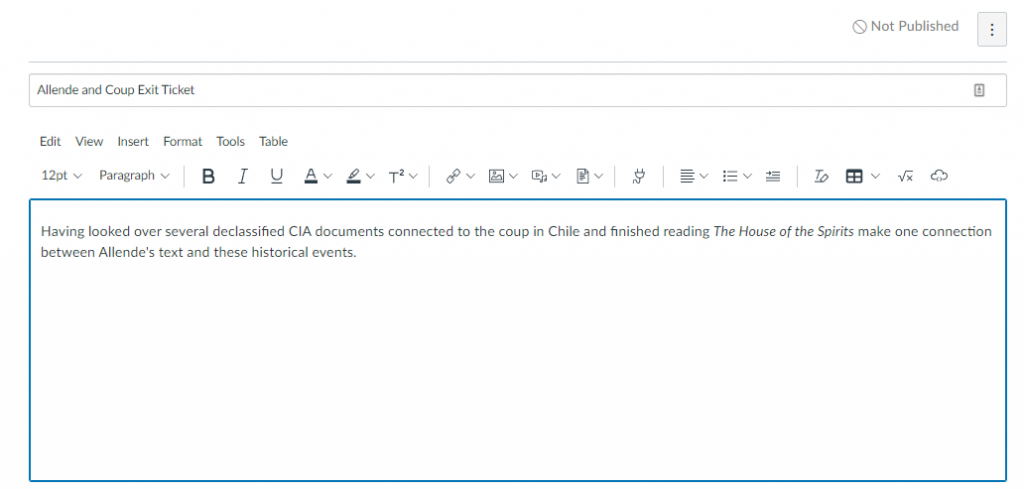
Differentiated Instruction & Assessment
Thinking back to my early years of teaching I realize that there were probably too few moments of differentiated instruction and assessment compared with my teaching today. As a new teacher, I was in the habit of creating extremely detailed assignment sheets and rubrics that left little room for students to make the work their own. The more students asked questions about the assignment the more I felt I needed to provide more detail in my instructions and grading. In retrospect, this was most likely born from the fear of not having total control over the lessons and assignments. Compounding this further was the fact that I typically had 35 students in a classroom and taught 7 out of 8 periods in a day. Even if I wanted to, creating meaningful differentiated assignments for that many students would be impossible.
The evolution of my pedagogy over the years with respect to differentiation has been a fun and also challenging. When developing assignments and assessments it’s easy to default into what I know and the ways I work best. It’s also challenging to know sometimes where a student may struggle on any given project. Differentiated instruction works best in my classroom when I know the students as individuals and understand ways in which they learn best. From there, I can design lessons with the good of the group in mind while allowing flexibility for students to bring their own strengths to the assignments. It’s a delicate balance. In practice this is seen in my classroom in the way daily lessons are structured, the balance between individual and group assignments, providing students with choice, and getting to know students one-on-one.
Perhaps most central to developing differentiated instruction and assessment is knowing the students well. The fact that I now teach 4 out of 8 periods a day and have class sizes not exceeding 18 makes this much easier.
(1) considers and addresses each student’s learning profile
I consider it essential to my role as an educator to be aware of student’s different strengths and challenges and adapt to them.
At the start of each trimester, I download and read the learning profiles for all students that have them so I can learn about them before we meet. Further, for students that are new to my classroom and have a learning plan, I make a point of meeting briefly with them before the first major assessment to go over the assignment as well as their accommodations. These meetings provide a great opportunity for me to get to know the student better and to ensure the assessment is structured in a way that helps the student be successful.
For my advisees, I always check in during my one-on-ones to see if they are using their accommodations and if the accommodations are working for them. I’ve found in the past that students sometimes forget that accommodations are available to them or do not think that they can be used on a particular assignment.
Learning Support at EPS has always been a great resource when students need an assignment adapted or are looking to use an accommodation. Something I really have come to appreciate with our learning support team is their attention to detail when it comes to the students. Below are two example email exchanges I had with Learning Support highlighting the way we work as a team.
Examples of communication between myself and Learning Support.
(2) designs class activities and assignments that engage and accommodate for both individual students and a diverse group of learners
Lorem ipsum dolor sit amet, consectetur adipiscing elit, sed do eiusmod tempor incididunt ut labore et dolore magna aliqua. Ut enim ad minim veniam, quis nostrud exercitation ullamco laboris nisi ut aliquip ex ea commodo consequat. Duis aute irure dolor in reprehenderit in voluptate velit esse cillum dolore eu fugiat nulla pariatur. Excepteur sint occaecat cupidatat non proident, sunt in culpa qui officia deserunt mollit anim id est laborum.
(3) builds in opportunities for each student to contribute during each class period
It’s my hope that the students in my class feel safe and supported when it comes to contributing each class period. I also recognize that speaking up in small group or whole class discussions, presenting a group project in front of the class, or simply raising a hand to ask a question does not come naturally to everyone. It’s easy to build in time during the class for students to contribute but if it’s not prefaced by creating a supportive environment it becomes pointless.
Some low stakes ways I build opportunities for students to participate is by simply asking an attendance question. It’s a great way to get students to speak up and share something about themselves with their neighbor then the class. “What are you looking forward to this weekend?” “What’s the best thing you’ve watched on Netflix lately?” In doing this students get become more comfortable hearing themselves speak up in class and are more likely to engage in the conversations centered on course content.
It’s common for students to feel more comfortable speaking in smaller groups with friends as opposed to being the center of attention in a Harkness discussion. But even in these smaller groups students can remain quiet, avoiding conversation. I combat this is by encouraging movement in the classroom. This video highlights students working in groups standing at the white board together. Each group has a different concept to discuss and each student has a marker with which to write on the board. The hope is that students can engage in the discussion at a level they are comfortable with. After they finish, the groups move around the room and look at the responses and students have an opportunity to share their thoughts.
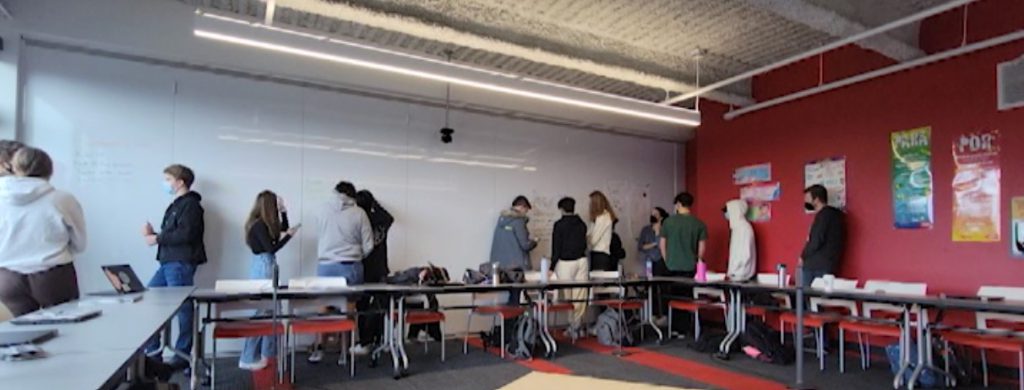
(4) provides alternative explanations of course concepts
[Need a more general intro before the example below]
The Modern Perspectives: European Literature course explores some of the most profound changes in human thought in history. For thousands of years most people had put their faith in Essentialism and had lived with the understanding that they were imbued with a purpose in life given to them by God. In the years leading up to and after WWI and WWII thinkers such as Sartre, Camus, Nietzsche began to question this concept and in their own way explore the idea that we may be born without purpose and that it’s our job to make meaning in our own lives.
On the surface it may seem like a fairly clear topic but teaching this concept through reading The Metamorphosis, and The Stranger is more complicated. Students first need to gain an understanding of life, art, and philosophy prior to the World Wars. The course hinges on the understanding that these wars drastically changed humanity. I start the course with a comparison of Victorian art and Modern art before moving into an analysis of T.S. Elliot’s poem The Love Song of J Alfred Prufrock.
We come back to the comparison of life before and after the World Wars often in the course as a way to highlight this dramatic change.
To show students the significance of the Modernist movement we look at emerging forms of art in the early 20th century. Surrealism, Dadaism, De Stijl, and Constructivism. Students research and present their findings answering the question of “How does the artistic movement highlight a reaction to the World Wars?” Next the students are asked to create their own work of art in the style of one of the four movements but as a response to events they currently face in life:

Though this process students learn more about the fundamental course concepts but also practice taking what they have learned and applying it to their life.
Assignment Sheet and Images of Student Art
(5) adapts instruction based on formative assessment
Our students are great at having high level discussions about literature. They ask thoughtful questions of one another, make contemporary and historical connections, and genuinely enjoy their time exploring the texts. Many of these discussions center on the central themes in the text, existentialism in The Stranger, exploring grand narratives in Postmodernism, United States intervention in Latin America in The House of the Spirits.
However, the details in the text, the rich language, thoughtful syntax and diction, significant literary devices, can be overshadowed in these larger conversations. After giving students formative assessments centered on reading comprehension I noticed that many students were not tracking some of the detail in the work. Students had difficulty identifying who said significant quotes based on context clues and were not able to describe the significance of individual lines in relation to the central themes within the text.
Verity Sayles and I had a discussion about the importance of close reading a text and employed the scaffolded assignment below to help students dig deep in their textual analysis.
